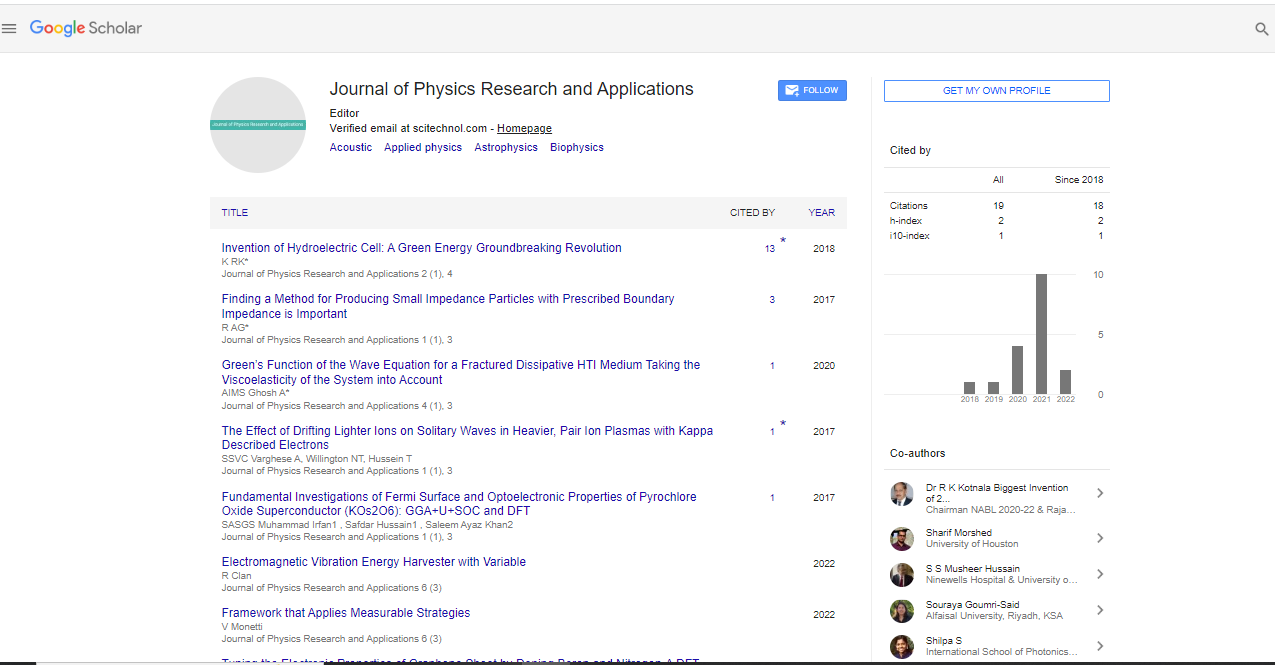Commentary, J Phys Res Appl Vol: 8 Issue: 3
Analysis of Gamma Rays and other Emissions for Nuclear Identification
Zhou Lie*
1Department of Physics, China Jiliang University, Hangzhou, China
*Corresponding Author: Zhou Lie,
Department of Physics, China Jiliang University,
Hangzhou, China
E-mail: lie@139826.cn
Received date: 26 August, 2024, Manuscript No. JPRA-24-151997;
Editor assigned date: 28 August, 2024, PreQC No. JPRA-24-151997 (PQ);
Reviewed date: 11 September, 2024, QC No. JPRA-24-151997;
Revised date: 18 September, 2024, Manuscript No. JPRA-24-151997 (R);
Published date: 25 September, 2024 DOI: 10.4172/JPRA.1000121.
Citation: Lie Z (2024) Analysis of Gamma Rays and other Emissions for Nuclear Identification. J Phys Res Appl 8:3.
Description
Nuclear identification is a field fundamental to nuclear physics and security depends heavily on the analysis of gamma rays and other types of radiation emitted by various materials. Gamma rays, which are a form of high-energy electromagnetic radiation, are produced in the decay of unstable atomic nuclei. Gamma-ray analysis is an invaluable tool in nuclear identification because it provides a noninvasive method for studying atomic and subatomic characteristics of matter. When a radioactive isotope decays, it often releases gamma rays as a means of moving from an excited state to a lower energy state. The energies of these gamma rays are unique to each isotope, acting as a "fingerprint" for identification.
Another widely used technique for gamma-ray analysis is scintillation detection. Scintillators, such as Sodium Iodide (NaI) crystals, produce visible light when gamma rays interact with them. This light is then converted into an electrical signal, which can be analyzed to determine the energy of the gamma ray. While scintillation detectors are less precise than HPGe detectors, they are more costeffective and can operate in a wide range of conditions, making them ideal for on-the-go or large-scale screening applications. Neutron emissions are also an important factor in nuclear identification, as some isotopes release neutrons during decay or nuclear reactions. Neutron Activation Analysis (NAA) is one technique that utilizes these emissions for identification purposes. In NAA, a sample is bombarded with neutrons, causing elements within the sample to capture neutrons and become radioactive. The newly formed radioactive isotopes emit gamma rays as they decay and the analysis of these emissions reveals the elemental composition of the sample. NAA is highly sensitive and capable of detecting trace amounts of elements, making it particularly useful for applications in geology, archaeology and forensics.
The use of gamma-ray and neutron emission analysis in nuclear identification has a broad range of practical applications. One prominent area is in nuclear security and non-proliferation. By analyzing the gamma-ray spectra of unknown materials, authorities can determine if they contain radioactive substances that could be used in nuclear weapons or "dirty bombs." The ability to accurately identify nuclear materials is crucial in border security and in the enforcement of international non-proliferation agreements, as it allows governments to monitor and control the movement of potentially dangerous materials.
Another significant application of gamma-ray analysis is in environmental monitoring. Radioactive contaminants, whether from nuclear power plants, accidents, or past nuclear testing, can pose longterm health risks to populations. By measuring gamma emissions from soil, water and air samples, scientists can track the spread and concentration of radioactive substances in the environment.
In medicine, gamma-ray analysis plays a vital role in both diagnostics and treatment. One of the most common diagnostic techniques, known as nuclear medicine imaging, involves the use of gamma-emitting radioisotopes. Patients are administered a small amount of a radioactive substance, which accumulates in specific tissues or organs. The emitted gamma rays are then detected by imaging devices to create detailed images of the body's internal structures, aiding in the diagnosis of diseases such as cancer and heart conditions. Furthermore, gamma rays are used in radiotherapy to target and destroy cancerous cells, demonstrating how gamma-ray analysis not only identifies nuclear materials but also contributes directly to human health.
 Spanish
Spanish  Chinese
Chinese  Russian
Russian  German
German  French
French  Japanese
Japanese  Portuguese
Portuguese  Hindi
Hindi 
